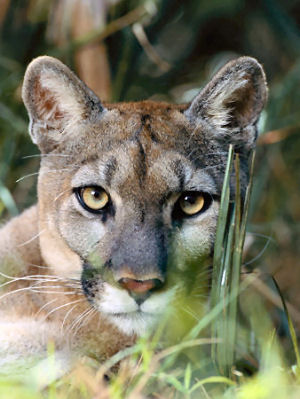Me and my big sister, Jenny, with Kinky in the window (before he put on a few pounds).
What my sister was up to in this picture, I have no idea,
but it probably involved corrupting my sweet, innocent, 2-year old mind.
Cats are a part of nature, and they have to eat too. Why is it bad that they eat wild animals?
The answer here is that domestic cats (Felis domesticus) are not a part of nature. They have been bred for thousands of years to be a companion to man, to dwell along side of us within our households. A cat is no more a part of nature than a domestic chicken, dog, or hamster.
This is why outdoor cats are such a sensitive topic among biologists--they are not a native and wild species but are having a profound impact on true wild native species. They not only cause a decrease in bird populations (cats are the number one cause of mortality for birds), but threatened and endangered species of other animal groups as well, including sea turtle hatchlings.
 |
| I think this is the expression Kinky would have had if we made him wear a collar like this. |
Cats are very, very, good hunters, and can learn to sneak along without causing a single bell chime. And because cats with bells on their collars learn to adapt their hunting style, it actually makes them even better and more efficient predators.
 |
| "I swear I wasn't going to put this at the foot of your bed." |
If I feed the stray/feral cats, they won't need to hunt.
This is one of the most common misconceptions about stray and feral cats, and unfortunately it is not true. Even a well fed cat still has its predatory instincts intact and will still hunt. A great example of this is cat owners who find little "gifts" in their house such as birds and lizards. The cats are well cared for and fed, but still catch and kill wildlife.
In addition, feeding stray and feral cats only causes their populations to increase. When an animal has ample resources for survival, its body's response is to breed. By providing more than enough food that the cats need to survive, they breed frequently and populations skyrocket. A female cat can start to breed as early as five months of age, and can have two to three litters a year. I may not have my calculator handy, but I can tell you that is a lot of cats! (But if you really want to see the math, look here)
 Cats only pose a risk to the animals that they hunt.
Cats only pose a risk to the animals that they hunt.Feral cats have introduced Feline Panleucopaenia (FPL), closely related to the lethal canine parvo, into not just other domestic cats, but wild cat species as well such as bobcats and panthers. Untreated, FPL has a 90% mortality rate. In Florida, the endangered Florida panther population has contracted FPL, further contributing to their decline.
So what can I do?
If you do see a stray or feral cat in your neighborhood, please do not feed it. Contact a local shelter or cat rescue; they may be able to help you find a home for your feline friend. If you have an outdoor cat, it is possible to convert it to be an indoor cat--be patient and stick with it...you can do it! There are many resources online for helping your cat (and yourself) make the transition from the urban to the indoor jungle while making sure your cat is still enriched mentally. Indoor cats live longer, healthier lives and in turn your backyard wildlife will live longer and healthier lives too!





No comments:
Post a Comment